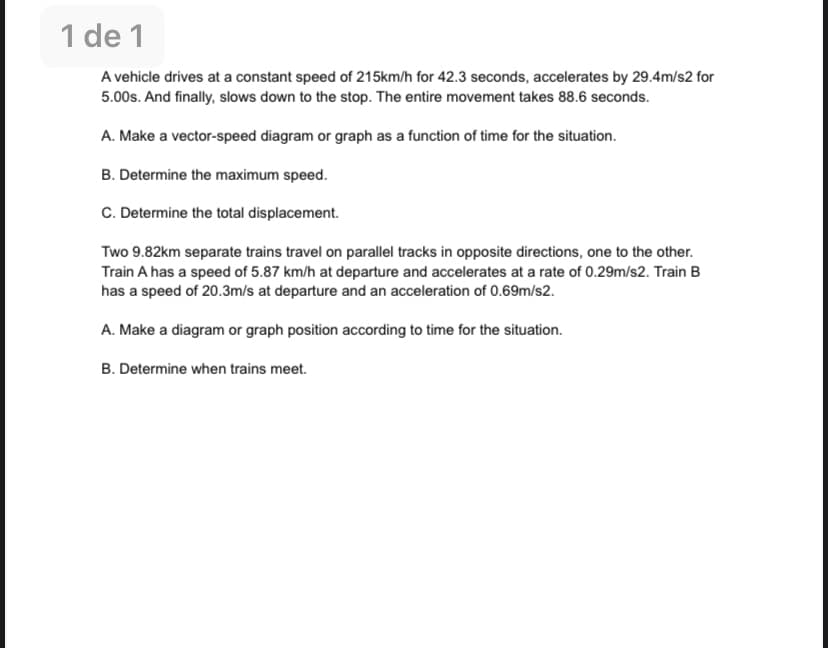1 de 1 A vehicle drives at a constant speed of 215km/h for 42.3 seconds, accelerates by 29.4m/s2 for 5.00s. And finally, slows down to the stop. The entire movement takes 88.6 seconds. A. Make a vector-speed diagram or graph as a function of time for the situation. B. Determine the maximum speed. C. Determine the total displacement.
1 de 1 A vehicle drives at a constant speed of 215km/h for 42.3 seconds, accelerates by 29.4m/s2 for 5.00s. And finally, slows down to the stop. The entire movement takes 88.6 seconds. A. Make a vector-speed diagram or graph as a function of time for the situation. B. Determine the maximum speed. C. Determine the total displacement.
College Physics
10th Edition
ISBN:9781285737027
Author:Raymond A. Serway, Chris Vuille
Publisher:Raymond A. Serway, Chris Vuille
Chapter2: Motion In One Dimension
Section: Chapter Questions
Problem 71AP: An ice sled powered by a rocket engine sum from rest on a large frozen lake and accelerates at + 40...
Related questions
Question
100%
A vehicle drives at a constant speed of 215 km/h for 42.3 seconds, accelerates by 29.4m/s2 for 5.00s, and finally slows down to stop. The entire movement takes 88.6 seconds.
B. Determine the maximum speed.
C. Determine the total displacement.
Two 9.82km separate trains travel on parallel tracks in opposite directions, one to the other. Train A has a speed of 5.87 km/h at departure and accelerates at a rate of 0.29m/s2. Train B has a speed of 20.3m/s at departure and an acceleration of 0.69m/s2.
B. Determine when trains meet.

Transcribed Image Text:1 de 1
A vehicle drives at a constant speed of 215km/h for 42.3 seconds, accelerates by 29.4m/s2 for
5.00s. And finally, slows down to the stop. The entire movement takes 88.6 seconds.
A. Make a vector-speed diagram or graph as a function of time for the situation.
B. Determine the maximum speed.
C. Determine the total displacement.
Two 9.82km separate trains travel on parallel tracks in opposite directions, one to the other.
Train A has a speed of 5.87 km/h at departure and accelerates at a rate of 0.29m/s2. Train B
has a speed of 20.3m/s at departure and an acceleration of 0.69m/s2.
A. Make a diagram or graph position according to time for the situation.
B. Determine when trains meet.
Expert Solution
This question has been solved!
Explore an expertly crafted, step-by-step solution for a thorough understanding of key concepts.
Step by step
Solved in 2 steps with 1 images

Recommended textbooks for you

College Physics
Physics
ISBN:
9781285737027
Author:
Raymond A. Serway, Chris Vuille
Publisher:
Cengage Learning

College Physics
Physics
ISBN:
9781938168000
Author:
Paul Peter Urone, Roger Hinrichs
Publisher:
OpenStax College

Physics for Scientists and Engineers: Foundations…
Physics
ISBN:
9781133939146
Author:
Katz, Debora M.
Publisher:
Cengage Learning

College Physics
Physics
ISBN:
9781285737027
Author:
Raymond A. Serway, Chris Vuille
Publisher:
Cengage Learning

College Physics
Physics
ISBN:
9781938168000
Author:
Paul Peter Urone, Roger Hinrichs
Publisher:
OpenStax College

Physics for Scientists and Engineers: Foundations…
Physics
ISBN:
9781133939146
Author:
Katz, Debora M.
Publisher:
Cengage Learning

Physics for Scientists and Engineers, Technology …
Physics
ISBN:
9781305116399
Author:
Raymond A. Serway, John W. Jewett
Publisher:
Cengage Learning

College Physics
Physics
ISBN:
9781305952300
Author:
Raymond A. Serway, Chris Vuille
Publisher:
Cengage Learning

University Physics Volume 1
Physics
ISBN:
9781938168277
Author:
William Moebs, Samuel J. Ling, Jeff Sanny
Publisher:
OpenStax - Rice University